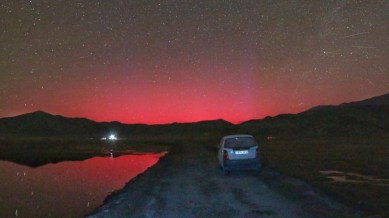Aurora Borealis visible across the world, parts of India: What causes this?
As beautiful as they can be, Aurora Borealis can cause complete blackouts and wireless network disruptions.

Aurora Borealis, also known as Northern Lights, is a phenomenon where the night sky lights up beautifully, displaying a wider range of colours.
Lakhs of people from across the world travel to countries like Iceland, Norway, Sweden, and Finland, located in the northern hemisphere, to experience the scientific spectacle.
monthly limit of free stories.
with an Express account.
However, Aurora Borealis is currently visible across North America and some parts of India, for the very first time. People who cannot afford the travel to witness the phenomenon are thrilled, but, what is causing this massive Aurora Borealis is a bit startling – an enormous solar storm that struck our planet.
What causes the Aurora Borealis?
Aurora Borealis appears in the sky when there is a solar storm. In simpler terms, it is caused due to an exponential increase in activity on the Sun’s surface, also known as a solar outburst. This causes the sky to light up during the night. It, however, has several adverse effects such as electrical outages, and it could also interfere with navigation systems and cause mild network blackouts.
Solar flares contain more charged particles. When they hit the particles in the Earth’s atmosphere, which mostly contain nitrogen and oxygen, it makes the sky appear blue, pink, and purple in colour. Digital cameras can capture the full spectrum of colours of Aurora Borealis.
After a gigantic solar storm, also called coronal mass ejections, struck the Earth, Elon Musk’s Starlink satellite network took a hit, hinting at the high intensity of the event. As per the Space Weather Prediction Center in the US, last night’s coronal mass ejections were classified as G4 or severe. G4 is considered the second highest grade, G5 being the highest, in the geomagnetic storms, known to disrupt power systems, spacecraft operations, and other systems.
Similar severe solar flares were last observed in 2003. It caused a bit of chaos with power failures and damages to transformers in Sweden. Currently, the storm is caused due to a cluster of sunspots in the dark and cool region, where the Sun is ejecting material once every six to 12 hours, and it’s speculated to continue for a few days.
Brent Gordon, chief of the space weather services branch at NOAA’s Space Weather Prediction Center, said, “We anticipate that we’re going to get one shock after another through the weekend.”
Why do solar flares disrupt communication and power?
Solar flares that cause Aurora Borealis can disrupt wireless communication and power, leading to cellular network outages, loss of radio signals, and can also break satellite navigation systems for both consumers and the military.
Solar flares are capable of fluctuating magnetic fields, inducing large currents, potentially damaging the hardware. Solar flares majorly affect electric grids that support wireless networks, and according to a report on CNN, in 1989, a solar flare caused a massive blackout in Quebec, Canada, damaging transformers and other equipment.
This time, the severity of the solar flare is causing the Aurora Borealis to appear in more regions than ever, including in India. Aurora lights have been visible in parts of Hanle and Ladakh.